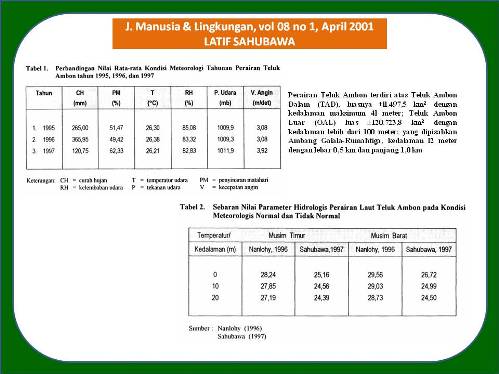
DAMPAK PEMBUANGAN LIMBAH TERHADAP PERUBAHAN KUALITAS OSEANOGRAFI BIOFISIK-KIMIA DAN PRODUKSI IKAN TERI (Stolephorus spp.) DI PERAIRAN LAUT TELUK AMBON (The Impact of Waste Disposal on the Biophysical-chemical Characteristics Changes and Teri fish)
Latif Sahubawa(1*)
(1) Jurusan Perikanan Fakultas Pertanian, Universitas Gadjah Mada, Yogyakarta, Indonesia
(*) Corresponding Author
Abstract
ABSTRAK
Tujuan penelitian adalah untuk: (l) mengidentifikasi karakteristik limbah hasil aktivitas manusia di pesisir teluk yang berpengaruh potensial terhadap penurunan sifat oseanografi biofisik-kimia perairan Laut Teluk Ambon; (2) mengevaluasi perubahan sifat oseanografi biofisik-kimia perairan dalam kaitannya dengan penyimpangan persyaratan peruntukkan sebagai tempat budi daya perikanan; dan (3) mengevaluasi pengaruh penyimpangan persyaratan peruntukan badan air laut terhadap potensi dan densitas ikan pelagis kecil, serta produksi ikan teri pada musim Timur dan Barat. Sampel penelitian terdiri atas air laut, ikan teri, dan kerang. Teknik pengambilan sampel ialah dengan pengacakan dan tanpa pengacakan. Teknik pengambilan data berupa survei, analisis laboratorium, wawancara, dan kuesioner. Metode analisis data Kurva Normal, Kuadrat Terkecil, Rancangan Acak Lengkap Pola Faktorial dan Berblok dengan Uji-F, Koefisien Nilai Nutrisi (KNN), Produksi Surplus, Hidroakustik, dan Sedimentasi Utermohl. Berdasarkan hasil analisis statistik, umumnya variabel penelitian tidak berpengaruh terhadap perubahan parameter oseanografi biofisik-kimia perairan Teluk Ambon, kecuali bahwa lokasi sampling berpengaruh terhadap nilai kecerahan pada tingkat signifikansi 95%. Kisaran nilai parameter oseanografi biofisik-kimia perairan laut ialah temperatur 23,7 - 28,7"C; TSS 2,005 - 12,436 mg/^; salinitas 24,00 - 35,50 mill; kecerahan 2,5 - 9,0 meter; pH 6,5 - 8,6; oksigen terlarut 2,09 - 6,88 mgA; BODs 10 - 50 mg/l; COD 22,5 - 150,8 mg/l; PO43- 0,22 - 3,29 mg/L, NQ-0.02 -2,94 mg/L; NO3- 21- 15,40 mg/L; Hg 0,001- 0,065 mg/L; KNN 0,27 -0/8 gr/cm; fitoplankton red-tede spesies Alexandrium affrne dengan jumlah 60,0 x 105 sel/liter menimbulkan perubahan warna perairan menj adi merah-kecoklatan. Produksi ikan teri pada musim Timur 191,5 ton (59,5 %) dan musim Barat 130,2 ton (40,5 %). Populasi maksimum telur dan larva ikan teri adalah 4.090 telur/SO mt pada musim Timur dan 396 ekor/50 m2 pada musim Barat di wilayah Ambang Galala-Rumahtiga. Potensi ikan pelagis kecil pada musim Timur 63.968,76 tor/tahun, Peralihan 56.311,55 ton/tahun, dan Barat 60.244,35 ton/tahun atau 3,86Vo dari total potensi ikan pelagis kecil perairan Maluku (1.564,000 ton/tahun). Densitas ikan pelagis kecit pab musim Timur 34,62 kg/m3, Peralihan 29,83 kg/m3, dan Barat 32,33 kg/m3. Tingkat eksploitasi sumber daya ikan pelagis kecil perairan Teluk Ambon yaitu 30 % ("status sedang berkembang").
ABSTRACT
The research objectives are: (1) identify the characteristics of waste from human activities that cause reduced biophysical-chemical oceanography characteristics of Ambon Bay Marine; (2) to evaluate the reduced biophysichemical oceanography characteristics of Ambon Bay marine in relation to assigmen requirements for fish aquaticulture; and (3) to evaluate the effect of assignment requirements fulfillment on the abundance and density of small pelagic fish, and teri fish production during Eastern and Western monsoons. Research samples consisted of sea water, teri fish, and mollusca. Sample collection methods were simple random and nonrandom sampling. Data were analyzed by using Norman Curve, Least Square, Factorial and Block completely Randomized Design with F-test, Nutritional Value Coefficient (NVC), surplus production, Hydroacoustic and Utermohl Sedimentation Methods. The results of the statistical analyses show that in general, the variables did not affect the biophysical-chemical oceanographic parameters of the Ambon Bay marine waters. The values range of the biophysical-chemical oceanography parameters of Ambon Bay marine are: temperature 23.7-28oC, TSS 2.005-12.436 mg/l, salinity 24.00-32.66 ppt, clearance 2.5-9.0 meters, pH 6.5-8.6, solved oxygen 2.09-6.88 mg/l, BOD5 10.0-50.0 mg/l, COD 22.5-150.8 mg/l, PO43- 0.22-329 µg/l, NO2- 0.22-2.94 µg/l, NO3- 0.21-15.40 µg/l, Hg in the water body 0.001-0.065 mg/l and mollusca meat 0.115-0.741 mg/l, and hydrocarbons 0.011-2.540 mg/l, NVC 0.27-0.78 gram/cm, red-tide phytoplankton of the alexandrium affine species that have 60.0x106 cells/liter, changes the water body color into the brownish-red. The production of teri fish during the Eastern monsoon was 191.5 tons (59.5%) and the Western monsoon 130.2 tons (40.5%). The abundance of small pelagic fish on the Eastern monsoon was 63,968.76 ton/year, the transition monsoon 56,311.55 tons/year, and the Western monsoon 60,244.35 tons/year, respectively, or 3.85% of small pelagic fish resources total on Moluccas waters (1,564,000 tons/year). The density of small pelagic fish on the Eastern monsoon was 34.62 kg/m3, the transition monsoon 29.83 kg/m3, and the Western monsoon 32.33 kg/m3. The exploitation rate of small pelagic fish resources in the Ambon Bay marine was 30% (still in the developing status).
Full Text:
ARTIKEL LENGKAP (PDF) (Bahasa Indonesia)Article Metrics
Refbacks
- There are currently no refbacks.
Copyright (c) 2017 Jurnal Manusia dan Lingkungan







